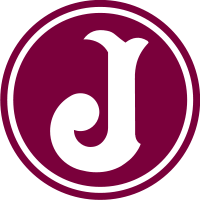Clube Atlético Juventus
 | |||
| Full name | Clube Atlético Juventus | ||
|---|---|---|---|
| Nickname(s) | Moleque Travesso (Prankster Boy) | ||
| Founded | April 20, 1924 (1924-04-20) | ||
| Ground | Conde Rodolfo Crespi (aka Rua Javari), São Paulo, Brazil | ||
| Capacity | 4,000 | ||
| President | Domingos Sanches | ||
| Head coach | Edmílson Jesus | ||
| League | Campeonato Paulista Série A2 | ||
| Website | Club website | ||
| |||
The Clube Atlético Juventus (Latin for Youth), usually known simply as Juventus, is a professional Brazilian football club based in Mooca, a São Paulo neighborhood. Although it was a Campeonato Brasileiro Série B (Taça de Prata) winner once, Juventus nowadays competes only in São Paulo tournaments, like Campeonato Paulista.
The team typically plays in maroon shirts and white shorts, and is nicknamed Moleque Travesso (the Prankster Boy).
Contents
1 History
2 Achievements
2.1 Professional competitions
2.2 Youth competitions
3 Stadium
4 Juventus in other years
5 Notable coaches
6 Symbols
7 Rivals
8 References
9 External links
History
Clube Atlético Juventus was founded on April 20, 1924 by Cotonificio Rodolfo Crespi employees, as Extra São Paulo.[1] The team colors were the colors of São Paulo state, black, white and red.[2]
The club changed its name to Cotonifício Rodolfo Crespi Futebol Clube in 1925,[1] and in 1930, the club changed its name again, to Clube Atlético Juventus,[2] because Count Rodolfo Crespi was a supporter of Juventus of Italy,[3] but the team colors are a homage to Italian club Torino Football Club,[4] because Rodolfo Crespi's son, Adriano, was a supporter of the club from Turin.[3]
Pelé states his most beautiful goal was scored at Rua Javari on a Campeonato Paulista match against Juventus on August 2, 1959.[5] As there was no video footage of this match, Pelé asked that a computer animation be made of this specific goal. This animation can be seen on Pelé Eterno, a documentary about his career.[6]
The club won the Copa FPF for the first time in 2007, after defeating Linense in the final,[7] and also competed in that season's edition of Recopa Sul-Brasileira.[8] Juventus was eliminated in the Campeonato Brasileiro Série C 2007's first stage.[9]
Achievements
Professional competitions
Campeonato Brasileiro Série B:
Winners (1): 1983
Campeonato Brasileiro Série C:
Runners-up (1): 1997
Copa FPF:
Winners (1): 2007
Campeonato Paulista Série A2:
Winners (2): 1929, 2005
Youth competitions
Copa São Paulo de Futebol Júnior:
Winners (1): 1985
Stadium

Juventus stadium
Juventus' home stadium is Estádio Rua Javari, inaugurated in 1929, with a maximum capacity of 4,000 people.
Juventus in other years
- Season 2008
- Season 2007
Notable coaches
 Basílio
Basílio
 Candinho
Candinho
 Edu Marangon
Edu Marangon
 Márcio Bittencourt
Márcio Bittencourt
Symbols
The anthem's author is Carlos Alberto de Jesus Polastro.[10]
The club is nicknamed Moleque Travesso, meaning the Mischievous Boy. The nickname was first used on September 14, 1930, by the journalist Thomaz Mazzoni, after Juventus beat Corinthians 2–1 at Estádio Parque São Jorge, which was Corinthian's home stadium at the time.[3]
Rivals
Juventus biggest rival is Nacional; the games between the two clubs are called Juvenal. Because of the poor performances of both teams on their championships, they've been relegated to different divisions and cannot play a match between them, since 2007. However, in 2014 Nacional AC was promoted from Second Division to Division A3, where Juventus has been played for a couple of years leading to a recent edition of the Juvenal in April 2015. Portuguesa is another direct rival of Juventus. Their matches are known as The Immigrants' Derby (Italians vs Portuguese).
References
^ ab "Juventus – A trajetória do Moleque Travesso" (in Portuguese). Veja São Paulo. Retrieved 2008-09-10..mw-parser-output cite.citation{font-style:inherit}.mw-parser-output .citation q{quotes:"""""""'""'"}.mw-parser-output .citation .cs1-lock-free a{background:url("//upload.wikimedia.org/wikipedia/commons/thumb/6/65/Lock-green.svg/9px-Lock-green.svg.png")no-repeat;background-position:right .1em center}.mw-parser-output .citation .cs1-lock-limited a,.mw-parser-output .citation .cs1-lock-registration a{background:url("//upload.wikimedia.org/wikipedia/commons/thumb/d/d6/Lock-gray-alt-2.svg/9px-Lock-gray-alt-2.svg.png")no-repeat;background-position:right .1em center}.mw-parser-output .citation .cs1-lock-subscription a{background:url("//upload.wikimedia.org/wikipedia/commons/thumb/a/aa/Lock-red-alt-2.svg/9px-Lock-red-alt-2.svg.png")no-repeat;background-position:right .1em center}.mw-parser-output .cs1-subscription,.mw-parser-output .cs1-registration{color:#555}.mw-parser-output .cs1-subscription span,.mw-parser-output .cs1-registration span{border-bottom:1px dotted;cursor:help}.mw-parser-output .cs1-ws-icon a{background:url("//upload.wikimedia.org/wikipedia/commons/thumb/4/4c/Wikisource-logo.svg/12px-Wikisource-logo.svg.png")no-repeat;background-position:right .1em center}.mw-parser-output code.cs1-code{color:inherit;background:inherit;border:inherit;padding:inherit}.mw-parser-output .cs1-hidden-error{display:none;font-size:100%}.mw-parser-output .cs1-visible-error{font-size:100%}.mw-parser-output .cs1-maint{display:none;color:#33aa33;margin-left:0.3em}.mw-parser-output .cs1-subscription,.mw-parser-output .cs1-registration,.mw-parser-output .cs1-format{font-size:95%}.mw-parser-output .cs1-kern-left,.mw-parser-output .cs1-kern-wl-left{padding-left:0.2em}.mw-parser-output .cs1-kern-right,.mw-parser-output .cs1-kern-wl-right{padding-right:0.2em}
^ ab "Juventus da Mooca, o teimoso "Moleque Travesso"" (in Portuguese). Diário do Comércio. Archived from the original on March 23, 2008. Retrieved 2008-09-10.
^ abc Enciclopédia do Futebol Brasileiro Lance Volume 1. Rio de Janeiro: Aretê Editorial S/A. 2001. p. 197. ISBN 85-88651-01-7.
^ "Clube Atlético Juventus – História" (in Portuguese). Federação Paulista de Futebol. Retrieved 2008-09-10.
^ "Um gol e um soco no ar" (in Portuguese). Diário do Comércio. Archived from the original on February 26, 2008. Retrieved 2008-09-10.
^ "Pelé Eterno" (in Portuguese). Adoro Cinema. Retrieved 2007-07-17.
^ "Linense vence, mas Juventus é campeão da Copa FPF" (in Portuguese). Estadão. 2007-11-25. Retrieved 2007-09-10.
^ "Marcílio Dias vence Juventus e decide título no sábado" (in Portuguese). Estadão. December 5, 2007. Archived from the original on April 21, 2009. Retrieved September 10, 2007.
^ "Brazil 2007 Championship – Third Level (Série C)". RSSSF. December 6, 2007. Archived from the original on October 13, 2007. Retrieved 2007-09-10.
^ "Clube Atlético Juventus – Hino do Juventus" (in Portuguese). Federação Paulista de Futebol. Retrieved 2008-09-10.
| Wikimedia Commons has media related to Clube Atlético Juventus. |
External links
(in Portuguese) Official website
(in Portuguese) Juventus Supporters website